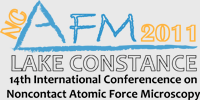1. Announcement: Proceedings NC-AFM 2011
Dear Participant of the NC-AFM 2011 Conference,
Every year, the organizing committee of the NC-AFM Conference Series arranges for a possibility to publish results presented at the conference in a high-quality journal. The goal is that the NC-AFM community is provided annually with a collection of papers assembled in one issue that give a comprehensive overview over the current state-of-the-art of this rapidly developing field. Due to the high visibility of these Speical Issues in the NC-AFM community, paper published in this series are highly cited.
In order to continue this tradition, the organizing committee of the NC-AFM 2011 Conference has teamed up with the Beilstein Journal of Nanotechnology. This new, peer-reviewed, open access journal publishes high-quality original articles on all aspects of nanoscience and nanotechnology. It provides a unique platform for rapid publication, highest visibility, and worldwide impact. I know that may of you will have reservations publishing in an open-access journal, especially if it is new, but there are good reasons why I hope you will support this effort:
- In recent years, many of the established scientific journals have dramatically increased their subscription fees charged to libraries and universities with the effect that many smaller institutions had to discontinue their subscriptions to select journals. For the Beilstein Journal of Nanotechnology, however, there are no fees for authors and readers and no page charges or charges for color - the Journal is completely funded by the Beilstein-Institut, a German non-profit foundation, as a service to the scientific community.
- Traditional open-access journals on the other hand require authors to pay often hefty page charges and are only available online, whereas the Beilstein Journal of Nanotechnology appears both online and in print for free.
- While articles submitted to the NC-AFM Special Issue will be published online on an ongoing basis (i.e., no wait once your article has been accepted), Beilstein will produce a printed issue that will be sent to all conference participants. Moreover, for broadest dissemination of your results, you can provide us with additional names and addresses when you submit your article and we will send additional hardcopy issues to these individuals free of charge.
More details about the aims and scope of the Journal and the Editorial and Advisory Board are given below or on the Journal's web site www.bjnano.org, where you can also find the instructions for authors and a description of the submission process. Articles for the special issue can be submitted any time (please indicate in your cover letter that it is for the NC-AFM 2011 Special Issue), but the official deadline is set to two months after the conference, on
Tuesday, November 22, 2011
As this date is still a while off, there is no need for immediate action, but I cordially invite you to plan ahead and to submit a manuscript once the time has come. Take full advantage of true Open Access publishing to disseminate your results with maximum impact and contribute to progress in the NC-AFM community by sending us your exciting research results.
Yours sincerely,
Udo D. Schwarz
Associate Editor, Beilstein Journal of Nanotechnology
Editor NC-AFM 2011 Proceedings
www.bjnano.org
General Information on the Beilstein Journal of Nanotechnology
1. Aims and Scope
The Beilstein Journal of Nanotechnology provides a broad coverage of both fundamental and applied research, including aspects of chemistry, physics and biology as well as materials science and engineering. The scope of the journal includes experimental and theoretical aspects as well as nanotechnology applications:
- Nanolithography, Soft lithography, Micro- and Nanoelectromechanical systems (MEMS and NEMS)
- Scanning Probe Techniques and Nanosensors
- Self-assembly, Self-organization and Pattern Formation on the Nanoscale
- Nanoparticles, Quantum Dots and Nanotubes
- Nanostructured Surfaces and Interfaces
- Nanomaterials
- Chemical Nanotechnology
- Nanobiology and Nanobiotechnology
- Nanomagnetics
- Nanoelectronics
- Nanophotonics, Nano-optics and Nanoscale Optical Microscopies
- Nanomechanics, Nanotribology and Nanomotors
- Theoretical Aspects and Concepts of Nanotechnology
- Nanotechnology Applications
2. Editorial Board
The Editorial Board consist of the following well-known scientists, all of whom are responsible for the manuscripts of their particular subject area:
- Prof. Thomas Schimmel, Editor-in-Chief, Karlsruhe Institute of Technology
- Prof. Wilhelm Barthlott, University of Bonn, Germany
- Prof. Bharat Bhushan, Ohio State University, USA
- Dr. Sidney R. Cohen, Weizmann Institute of Science, Israel
- Prof. Armin Gölzhäuser, University of Bielefeld, Germany
- Prof. Kerstin Koch, Hochschule Rhein-Waal, Germany
- Prof. Paul Leiderer, University of Konstanz, Germany
- Prof. Alfred Meixner, University of Tübingen, Germany
- Prof. Ernst Meyer,University of Basel, Switzerland
- Prof. Daniel J. Müller, University of Basel, Switzerland
- Prof. Jürgen Rühe, University of Freiburg, Germany
- Prof. Jan van Ruitenbeek, University of Leiden, The Netherlands
- Prof. Jörg Schneider,Technical University Darmstadt, Germany
- Prof. Udo D. Schwarz, Yale University, USA
- Prof. Paul Ziemann, University of Ulm, Germany
3. Advisory Board
- Prof. Christoph Gerber, University of Basel, Switzerland
- Prof. Herbert Gleiter, Karlsruhe Insitute of Technology, Germany
- Prof. Wolfgang Heckl, Director General of the Deutsches Museum, Germany
- Prof. Sir Harold Kroto, University of Florida, USA
- Prof. Jean-Marie Lehn, University of Strasbourg, France
- Prof. Sir Fraser Stoddart, Northwestern University, USA
The Editorial and the Advisory Board will be further expanded in the future.




